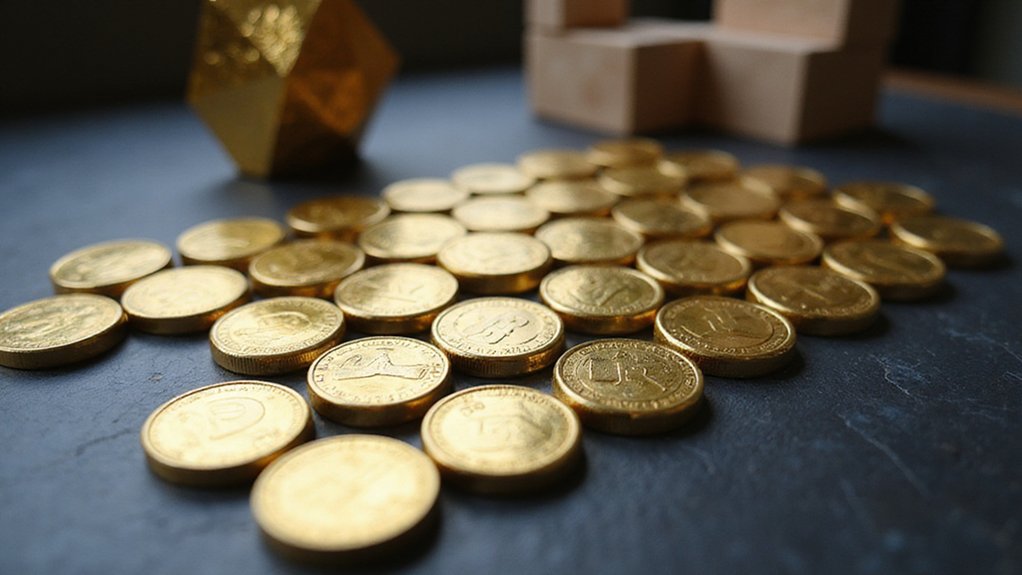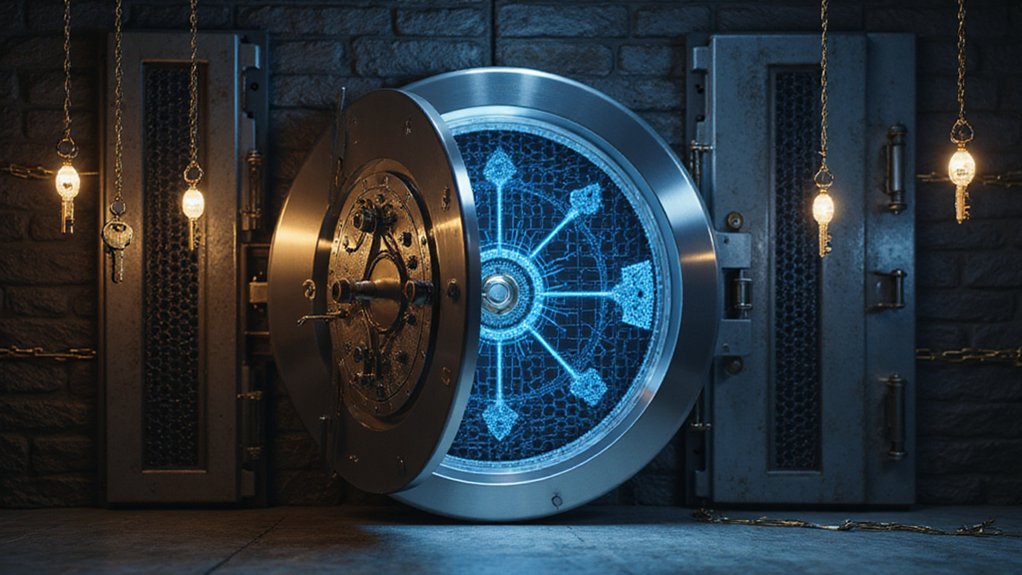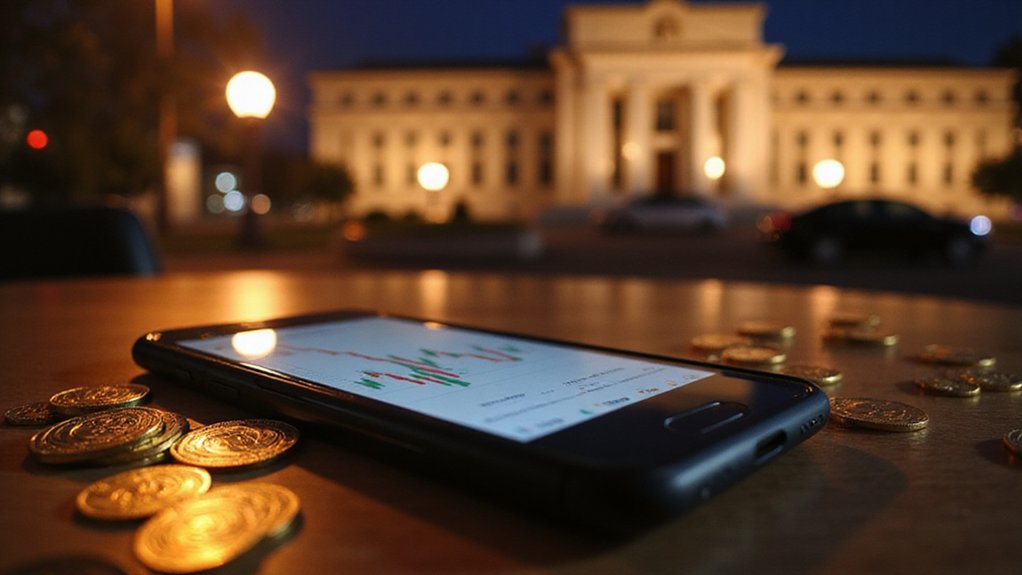ERC-20 tokens function as standardized digital assets on Ethereum’s blockchain, operating through smart contracts that enforce predetermined rules for transfers, balance checks, and third-party approvals. These fungible tokens—each unit identical and interchangeable—emerged from early blockchain chaos when incompatible assets created integration nightmares for developers and exchanges. The standard now governs over 350,000 tokens, from stablecoins like USDC to meme coins like Shiba Inu, with deeper mechanics revealing fascinating complexities.

The digital revolution that transformed finance has produced few innovations as foundational—yet occasionally misunderstood—as the ERC-20 token standard, a technical specification that solved what was becoming an increasingly chaotic landscape of incompatible digital assets on the Ethereum blockchain.
Standing for Ethereum Request for Comment 20, this standard emerged from the rather pressing need to impose order on what developers were creating with wild, creative abandon—tokens that behaved so differently from one another that integration became a Sisyphean task.
Before ERC-20’s arrival, token creators operated in a fragmented ecosystem where each implementation followed its own logic, creating predictable headaches for wallet developers, exchanges, and decentralized applications trying to support multiple assets.
The standard fundamentally mandated a common language: specific functions for transferring tokens, checking balances, and—perhaps most cleverly—allowing third-party spending approvals, all while maintaining transparent event logging for blockchain tracking.
ERC-20’s brilliance lies in mandating universal functions—transfers, balance checks, and third-party approvals—creating seamless blockchain interoperability through standardized communication.
What makes ERC-20 tokens particularly elegant is their fungible nature, meaning each unit remains identical and interchangeable (unlike their attention-seeking NFT cousins). This characteristic proves crucial for representing everything from cryptocurrency assets and utility tokens to governance rights and membership privileges.
Smart contracts govern these tokens according to predetermined rules, with developers deploying contracts that automatically adhere to standardized functions—a template approach that dramatically reduces development complexity.
The practical applications span an impressive range: facilitating payments, granting access to decentralized services, enabling voting mechanisms, and powering the Initial Coin Offering boom that captivated (and occasionally traumatized) investors. Popular implementations include stablecoins like Tether USD and USD Coin alongside other widely-traded assets such as Shiba Inu and DAI.
The standard’s success lies in its interoperability—tokens created under ERC-20 work seamlessly across the Ethereum ecosystem without requiring custom integration for each platform. ERC20 wallets serve as essential digital tools that enable users to store, send, and manage these standardized tokens while facilitating interaction with decentralized applications and exchanges.
Today, most Ethereum-based tokens conform to ERC-20, transforming it into the dominant format on the network. The remarkable adoption demonstrates the standard’s influence, with over 350,000 ERC-20 assets now existing on the Ethereum blockchain.
This standardization fostered broader ecosystem growth by providing developers with reliable building blocks, proving that sometimes the most revolutionary innovation isn’t the flashiest technology, but rather the boring infrastructure that makes everything else possible.
The result: a coherent token economy where compatibility isn’t an afterthought but a fundamental feature.
Frequently Asked Questions
Can ERC-20 Tokens Be Converted Back to Ethereum?
ERC-20 tokens readily convert back to Ethereum through decentralized exchanges like Uniswap or centralized platforms such as Coinbase.
The process involves approving token spending allowances, executing swap transactions, and paying gas fees—assuming the token maintains liquidity and market value.
While technically straightforward, users must navigate fluctuating conversion rates, verify platform legitimacy, and occasionally endure the peculiar reality that some tokens prove worthless despite their initial promise.
What Fees Are Involved When Transferring ERC-20 Tokens?
Transferring ERC-20 tokens involves dual fee structures that catch many investors off-guard.
Network gas fees (paid in ETH, averaging $0.68 but highly volatile) cover blockchain execution costs, while some tokens impose additional transfer fees—occasionally reaching 7% or more of transaction value.
These token-specific fees, ostensibly supporting tokenomics but sometimes resembling rent-extraction schemes, get deducted from transferred amounts, creating unexpected losses for the unwary.
How Do I Store ERC-20 Tokens Safely?
Hardware wallets like Ledger or Trezor provide excellent security by storing private keys offline, requiring manual transaction approval.
Software wallets demand rigorous practices: using audited applications, enabling two-factor authentication, and maintaining updated firmware.
Users must carefully manage token approvals—auditing smart contracts before interaction and regularly revoking unnecessary permissions.
Recovery phrases require secure offline storage across multiple locations, while transaction monitoring and strong unique passwords complete the security framework for protecting digital assets.
Can ERC-20 Tokens Work on Other Blockchains Besides Ethereum?
ERC-20 tokens can indeed operate beyond Ethereum through several mechanisms.
EVM-compatible blockchains like Binance Smart Chain and Polygon support these tokens natively or through wrapped versions.
Cross-chain bridges facilitate token movement by locking originals and minting equivalents elsewhere—though one might question whether a “wrapped” token truly remains the same asset.
Non-EVM chains require more complex bridging solutions, expanding utility while introducing additional trust assumptions and technical complexities.
What Happens to ERC-20 Tokens if Ethereum Network Fails?
If Ethereum fails, ERC-20 tokens fundamentally become digital ghosts—existing in theory but functionally worthless since they cannot be transferred, traded, or accessed.
The tokens remain trapped within Ethereum’s smart contracts, rendering wallets useless and exchanges unable to process transactions.
Token values would likely collapse as markets freeze, leaving holders with assets they can observe but cannot move—a peculiar form of digital purgatory until network restoration occurs.









